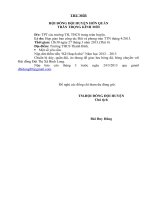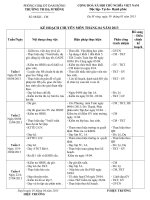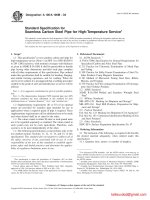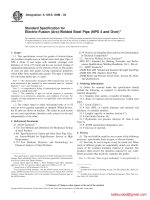Astm e 1265 04 (2013)
Bạn đang xem bản rút gọn của tài liệu. Xem và tải ngay bản đầy đủ của tài liệu tại đây (218.01 KB, 6 trang )
Designation: E1265 − 04 (Reapproved 2013)
Standard Test Method for
Measuring Insertion Loss of Pneumatic Exhaust Silencers1
This standard is issued under the fixed designation E1265; the number immediately following the designation indicates the year of
original adoption or, in the case of revision, the year of last revision. A number in parentheses indicates the year of last reapproval. A
superscript epsilon (´) indicates an editorial change since the last revision or reapproval.
S1.33 Engineering Methods for the Determination of Sound
Power Levels of Noise Sources in a Special Reverberation
Room
B2.1 Taper Pipe Thread (NPT)—Standard Designation for
Tapered Pipe Threads
2.3 Federal Standard:
Rules and Regulations—Hand and Portable Power Tools and
Equipment4
1. Scope
1.1 This test method covers the laboratory measurement of
both the acoustical and mechanical performance of pneumatic
exhaust silencers designed for quieting compressed gas (usually air) exhausts from orifices connected to pipe sizes up to 3⁄4
in. NPT. This test method is not applicable for exhausts
performing useful work, such as part conveying, ejection, or
cleaning. This test method evaluates acoustical performance
using A-weighted sound level measurements.
3. Terminology
1.2 The values stated in inch-pound units are to be regarded
as standard. The values given in parentheses are mathematical
conversions to SI units that are provided for information only
and are not considered standard.
1.3 This standard does not purport to address all of the
safety concerns, if any, associated with its use. It is the
responsibility of the user of this standard to establish appropriate safety and health practices and determine the applicability of regulatory limitations prior to use. Specific precautionary statements are given in Section 8.
3.1 Definitions—For definitions of terms used in this test
method, see Terminology C634. Particular terms of interest
are: sound level and average sound pressure level.
3.2 Definitions of Terms Specific to This Standard:
3.2.1 flow ratio—the ratio of gas flow with the pneumatic
exhaust silencer installed relative to flow of the unrestricted
pipe.
3.2.2 flow resistance—the reduction of fluid flow caused by
various restrictions, surface roughness, devious paths,
obstacles, etc. This term is sometimes referred to as “back
pressure.”
3.2.3 Discussion—For this test method back pressure is a
qualitative term, therefore, there is no need to measure.
3.2.4 insertion loss of a pneumatic exhaust silencer (at a
specific supply pressure)—the difference in average
A-weighted sound levels measured with and without the
pneumatic exhaust silencer installed on an unrestricted or
“open” pipe.
2. Referenced Documents
2.1 ASTM Standards:2
C634 Terminology Relating to Building and Environmental
Acoustics
2.2 ANSI Standards:3
S1.4 Specification for Sound Level Meters
S1.13 Method for the Measurement of Sound Pressure
Levels
S1.31 Precision Method for the Determination of Sound
Power Levels of Broad-Band Noise Sources in Reverberation Rooms
3.2.5 Discussion —Insertion loss, as defined in this test
method, differs from the definition in Terminology C634. As
stated in 1.1, this test method uses A-weighting rather than
discrete frequency bands. It compares a set of sound pressure
data measured in a reverberation room rather than determining
absolute sound power levels. This test method is intended to
assess the difference in sound regenerated at the pipe orifice
and does not evaluate sound propagating along the pipe
interior.
1
This test method is under the jurisdiction of ASTM Committee E33 on Building
and Environmental Acoustics and is the direct responsibility of Subcommittee
E33.08 on Mechanical and Electrical System Noise.
Current edition approved Feb. 1, 2013. Published February 2013. Originally
approved in 1988. Last previous edition approved in 1995 as E1265 – 90 (1995)ε1,
which was withdrawn July 2004 and reinstated August 2004. DOI: 10.1520/E126504R13.
2
For referenced ASTM standards, visit the ASTM website, www.astm.org, or
contact ASTM Customer Service at For Annual Book of ASTM
Standards volume information, refer to the standard’s Document Summary page on
the ASTM website.
3
Available from American National Standards Institute (ANSI), 25 W. 43rd St.,
4th Floor, New York, NY 10036, .
4
This United States Occupational Safety and Health Administration Regulation,
Federal Register, Vol 36, Number 105, Part II, p. 10653, May 1971, is available
from Superintendent of Documents, Government Printing Office, Washington, DC
20402–9371.
Copyright © ASTM International, 100 Barr Harbor Drive, PO Box C700, West Conshohocken, PA 19428-2959. United States
1
E1265 − 04 (2013)
NOTE 1—Reverberation rooms as small as 17 m3 are sufficient for
making A-weighted measurements of noise generated by pneumatic
exhaust silencers. The minimum volume of 70 m3 recommended in ANSI
S1.33 can be ignored.
3.2.6 pneumatic exhaust silencer—a device attached to a
pipe fitting or orifice. The silencer reduces the sound produced
when the released pressurized exhaust gases (usually air),
merge with ambient (static) air in the region surrounding the
orifice. Such silencers are not usually intended to perform
useful work such as part conveying, ejection, or cleaning. The
port sizes of the pneumatic exhaust silencers addressed by this
test method are: 1⁄8, 1⁄4, 3⁄8, 1⁄2, 5⁄8, and 3⁄4 in. NPT (based on the
American National Standard Taper Pipe Thread designation,
(B.2.1), specified in fractions of an inch).
6.3 The performance of pneumatic exhaust silencers tends
to deteriorate over time, due to clogging and other factors. The
primary purpose of this test method is to evaluate the optimum
performance of pneumatic exhaust silencers, therefore only
new or unused silencers should be tested. This test method may
also be used to measure the performance of a silencer during its
actual or simulated service life.
4. Summary of Test Method
7. Apparatus
4.1 A special air reservoir system terminates in a reverberation room where acoustical measurements are made to assess
the sound produced by both an open pipe and the pipe
terminated with a silencer. Both flow volume and A-weighted
sound level measurements are made as the air supply valve is
opened between the reservoir and the piping system. The test
procedure is repeated for three air reservoir pressures both with
and without silencer. The flow ratios are calculated from the
flow volumes with an unrestricted pipe and with the silencer.
The insertion loss is determined by the difference in
A-weighted sound levels. This is done for each of the three air
reservoir pressures. The overall pneumatic exhaust silencer
performance is then reported as insertion loss versus flow ratio.
7.1 Reverberation Room:
7.1.1 The reverberation room shall conform to the requirements in ANSI S1.33, except for the minimum volume. (See
Note 1.)
7.1.2 The reverberation room shall be equipped with a
duct-type muffler or silencer to control static air pressure while
simultaneously reducing extraneous sound entering the test
room from adjacent areas.
7.1.2.1 This duct-type muffler shall have an adequate“ free”
cross-sectional area to allow the air introduced by the test
process to be vented rapidly, relieving the pressure within the
test room. The static pressure in the reverberation room shall be
measured initially while testing the largest open pipe to
determine if the free cross-sectional area is adequate to allow
air to escape. If the gage pressure5 rises to more than 4 kPa,
then the cross-sectional area of the duct or the room volume
must be increased.
7.1.2.2 The construction of the duct-type muffler and the
reverberation room shall be adequate to ensure that the
background sound level within the test room is at least 10dB
below the lowest sound level measured during the evaluation.
The muffler shall also be so selected as to avoid “selfgenerated” sound.
5. Significance and Use
5.1 This test method permits the evaluation of both the
acoustical and mechanical performance of pneumatic exhaust
silencers designed for quieting compressed gas exhausts (usually air). The data can be used by manufacturers to assess or
improve their products, or by users to select or specify a
silencer. The data acquired using this measurement method
allow for performance comparisons of competitive products
and aid in the selection of an appropriate device.
5.2 Flow rate is an important parameter to consider when
the application involves machinery or equipment that requires
compressed air or other gases to be exhausted rapidly. For
example, in an automatic pneumatic press, compressed air
must be exhausted rapidly to avoid a premature second cycle.
For this reason, flow ratio is reported in addition to acoustical
performance.
7.2 Piping System:
7.2.1 The test apparatus shall consist of a system similar to
that shown in Fig. 1. The critical elements are the compressortank capacity, size of supply pipes and method of assembly,
lengths of certain pipe sections, and design of devices in the air
stream (that is, valves, regulators, flow meters, temperature,
and pressure sensors).
7.2.1.1 Reservoir Capacity—The minimum air reservoir
size is determined by the maximum unrestricted pipe diameter
planned for the test. Use a reservoir whose size is adequate to
permit obtaining three contiguous 1 s average sound levels
within 2 dB of each other (see 9.3.3.2).
6. Assumptions
6.1 Studies have shown that the sound level (in decibels)
produced by quieted pneumatic exhausts generally is linear
with supply pressure for the range of pressures covered in this
test method. It is assumed that the air supply pressures called
for in this test method include those typical of most applications. Sound levels may be extrapolated for silencers operating
at pressures slightly beyond the test range. A linear relationship
can be assumed between discrete test supply pressures.
NOTE 2—Based on experience, the minimum storage tank capacity for
testing 1⁄8 in. NPT devices is approximately 2.8 ft3 (0.08 m3). The
minimum air reservoir size should be increased proportionally for larger
test specimens.
7.2.1.2 If a dedicated compressor and air reservoir are
located near the test site and the piping meets the
6.2 Generally, the sound power produced by pneumatic
exhausts is dominant in the frequency range from 500 to
10 000 Hz. This frequency range allows testing in a relatively
small reveberation room. ANSI Standard S 1.33 (Appendix A),
provides guidelines for the design of an appropriate test room.
5
The Magnehelic gage, available from F.W. Dwyer Co., P. O. Box 3029, 1123
Mearns Rd., Ivyland, PA 18974, or equivalent, has been found satisfactory for this
measurement.
2
E1265 − 04 (2013)
FIG. 1 Apparatus for Pneumatic Exhaust Silencers
specifications, the separate air reservoir of 7.2.1.1 may be
eliminated. Once the required supply pressure has been
reached, the compressor motor must be shut down to ensure
that the compressor does not restrict as the air pressure is
released for the test.
7.2.1.3 Water Trap—The system shall be equipped with a
water trap (preferably at the tank outlet) to collect condensed
water and provide a means for draining moisture from the
system.
7.2.1.4 Supply Pipes—All pipes in the system shall be
Schedule 40 cast iron, steel, copper, or poly(vinyl chloride)
(PCV). The final downstream segment of pipe shall be a
minimum of 1 m-long steel or cast iron, appropriately sized for
the pneumatic exhaust silencer under test.
NOTE 3—Steel or cast iron is necessary to reduce transmission of sound
through the pipe wall into the reverberation room.
NOTE 1— Minimum dimensions in metres.
7.2.1.5 Method of Assembly—When assembling pipe
components, avoid irregularities and obstructions that restrict
flow or create unwanted turbulence. Burrs shall be removed
and pipe threads properly mated to avoid exposed threads in
the gas stream. Changes in size and direction shall be accomplished with the minimum number of fittings. This is particularly important in the final pipe section and at the orifice where
the pneumatic exhaust silencer is to be installed.
7.2.1.6 Minimum Pipe Section—The pipe section located
between the pressure sensor and the pneumatic exhaust
silencer, shall be a straight section at least 1 m long to avoid
turbulence prior to the silencer (see Fig. 1). Lengths of pipe
between the storage tank and pressure sensor shall be kept to a
minimum to avoid flow-generated pressure losses.
7.2.1.7 The final segment of pipe shall be positioned in the
reverberation room so the pneumatic exhaust silencer under
test is at least 1 m from any room surface. (See Fig. 2.)
FIG. 2 Microphone Location for Pneumatic Exhaust Silencers
7.2.1.8 Valves, regulators, flow meters, temperature, and
pressure sensors located in the test air stream shall be designed
to minimize flow restriction and turbulence. A “ball” valve
(straight-flow ball type, or equivalent) is recommended for
flow control. This valve shall have an inside diameter equal to
the inside diameter of the upstream and downstream pipe
segments connected to the valve. The temperature sensor shall
be located on the air reservoir rather than in the supply piping.
The flow meter should preferably be a hot-wire anemometer or
an electronic thermal mass flow sensor due to their minimal
effect on the airstream.
NOTE 4—Vortex-shedding flow meters that require a “blunt object” in
the airstream shall not be used. Similarly, differential-pressure transmitter
flow meters, that require a flow restricting orifice plate, shall not be used.
3
E1265 − 04 (2013)
such as those maintained by the National Institute of Standards
and Technology (NIST).
9.1.2.2 Prior to each test session, calibrate the flow measurement equipment.
9.1.2.3 Establish accuracy and linearity of the flow measurement system by determining flow of the unrestricted pipe
with known conditions. Volume of the storage tank must be
determined as well as pressure and temperature of the compressed air. Measure flow over some specific brief period of
time and determine the subsequent pressure and temperature.
Initially, use this test method over the pressure range of interest
(using at least three supply pressures) to establish linearity of
the flow measurement system.
It may be possible to use a differential-pressure transmitter flow meter in
conjunction with a venturi, flow nozzle, or pitot tube to minimize flow
restriction.
7.2.1.9 Precision Regulator, shall be provided prior to the
air reservoir specified in 7.2.1.1. This regulator shall not allow
pressure in the air reservoir to vary more than 2 % regardless
of supply pressure variation.
7.2.1.10 “In-line” silencers (for treatment of sound within
the airstream) are not recommended. These silencers may
create undesirable flow restriction or turbulence. Sound propagating downstream from the compressor or other sources is not
expected to influence the test results.
7.2.1.11 In instances where both a compressor and air
reservoir are used, vibration isolation must be provided for the
piping system to reduce potential structure-borne noise. This
can be accomplished by installing a section of reinforced
flexible hose between the compressor and the air reservoir.
9.2 General Measurements—Make the following measurements in the reverberation room: barometric pressure, relative
humidity, and temperature of the air supply (a sample data
sheet is shown in Fig. 3).
7.3 Acoustical Instrumentation:
7.3.1 The sound level meter, microphone, and any associated instrumentation shall meet the requirements for a “Type 1
Precision” sound level meter as specified in ANSI S1.4. Sound
level measurements shall be made with A-weighted frequency
characteristics. The instrumentation shall be capable of measuring sequential 1 s average sound pressure levels (as specified in Terminology C634).
9.3 Sound Level Measurements:
9.3.1 To avoid flow-generated noise, equip the microphone
with a suitable wind screen in accordance with ANSI S1.13,
Section 5.7.1.1.
9.3.2 Position the microphone in the reverberation room so
that it represents the spatial average sound level. The minimum
distance to any room surface shall be at least 1 m as shown in
Fig. 2. In addition, the microphone in the reverberation room
shall be at least 1 m from the pneumatic exhaust silencer under
test. Measure the background A-weighted sound level in the
reverberation room prior to and following each pneumatic
exhaust silencer evaluation.
9.3.3 Perform the following tests at three supply pressures:
60, 80, and 100 psig (414, 552, and 690 kPa).
9.3.3.1 Measure the A-weighted sound level using an unrestricted pipe with the same port size as the pneumatic exhaust
silencer under test. Measure the sound level as the ball valve is
rapidly opened, supplying compressed air to the piping system.
8. Hazards
8.1 Caution should be exercised when working with compressed gas (air) to avoid the risk of injury. The Occupational
Safety and Health Administration (OSHA) has established a 30
psig blocked static air pressure limit for hand-held air guns and
nozzles (see 2.3). Since this test method uses air pressure in
excess of 30 psig, personnel conducting tests in accordance
with this test method should avoid directing the flow of air at
the skin or clothing.
NOTE 5—Typically these valves can be fully opened in less than 1⁄2 s.
9. Procedure
9.3.3.2 Acquire three A-weighted sound levels over successive 1 s intervals to the nearest 1⁄2 dB (or better). If the range
of the data is within 2 dB, calculate the arithmetic average of
the three values. (See Terminology C634).
9.1 Calibration:
9.1.1 Acoustical:
9.1.1.1 Calibrate the instrumentation, including the acoustical calibrator, and certify at intervals not exceeding one year,
by a qualified facility (refer to ANSI S1.4, Section 8). It is
recommended that calibration be traceable to a primary reference standard such as those maintained by the National
Institute of Standards and Technology (NIST).
9.1.1.2 Prior to the initial daily measurements, calibrate the
measurement instruments in accordance with ANSI S1.13,
“Calibration and Maintenance of Instrumentation,” (Section
5.6). This calibration shall include measurements to confirm
appropriate level and frequency response using an acoustical
calibrator in accordance with ANSI S1.33, “Calibration,”
Section 5.6.
9.1.2 Flow:
9.1.2.1 Calibrate temperature, flow, and pressure meters and
sensors and certify them periodically by a qualified facility
(intervals not exceeding one year are recommended). This
calibration shall be traceable to a primary reference standard
NOTE 6—If the sound level drops so rapidly that the range of data
values exceeds 2 dB, the measurement cannot be made in accordance with
this test method. In this case, it is likely that a greater capacity storage tank
will be required to evaluate the pneumatic exhaust silencer under test.
Figs. 4 and 5 are examples of this problem. Fig. 4 shows acceptable
conditions, Fig. 5 shows unacceptable conditions.
9.3.3.3 Obtain the sound level measurements immediately
after the valve is opened. If operation of the valve generates an
acoustical transient, then the first three successive 1 s sound
levels within 2 dB after the transient should be used. Do not
begin the first sound level measurement beyond 2 s after
opening the valve.
9.3.3.4 Install the pneumatic exhaust silencer on the pipe
orifice and the measurements of 9.3.3.2 shall be repeated.
9.4 Flow Measurements:
9.4.1 Measure air flow volume, in standard cubic feet per
minute (SCFM) or litres per second (L/s), when the control
4
E1265 − 04 (2013)
FIG. 3 Sample Data Sheet for Testing Pneumatic Exhaust Silencers
FIG. 4 Acceptable Conditions for Measuring A-Weighted Sound
Levels
FIG. 5 Unacceptable Conditions for Measuring A-Weighted
Sound Levels
occur during the acoustical measurement interval, the measurements cannot be made in conformance with this test method. In
this case, it is likely that an air reservoir of greater capacity will
be required to evaluate the pneumatic exhaust silencer under
test.
valve is opened, supplying compressed air to the piping
system. Conduct flow measurements at each of the three
standard supply pressures simultaneous with the sound measurements. Conduct flow measurements with both the unrestricted pipe and with the pneumatic exhaust silencer mounted.
9.4.2 Flow should be relatively constant during the acoustical measurements. Measure the average flow over the 3 s
measurement interval. If flow variations greater than 62 %
10. Calculation
10.1 The following computations shall be performed for
each silencer tested at the three standard air supply pressures.
5
E1265 − 04 (2013)
10.1.1 Flow Ratio—The gas flow with the pneumatic exhaust silencer installed divided by the flow of the open pipe,
dimensionless.
10.1.2 Average Insertion Loss—The difference in
A-weighted sound levels measured with and without the
pneumatic exhaust silencer installed on an unrestricted pipe,
for a specific air pressure, expressed in decibels.
11. Report
11.1 The pneumatic exhaust silencer performance shall be
provided in tabular form for the three air supply pressures
tested. For comparison purposes, this information can also be
plotted with insertion loss (decibels) on the ordinate axis and
flow ratio (dimensionless) on the abscissa. A sample plot is
shown in Fig. 6.
11.2 The sound levels measured using the unrestricted pipe
shall be reported. These data will help ensure that the test
facility is representative of other facilities.
FIG. 6 Plot for Pneumatic Silencer Performance
12.2 At the present time, no information is available to
develop this section. A round-robin evaluation is planned.
Upon completion of the round robin, a precision and bias
statement will be submitted to support the test method.
12. Precision and Bias
12.1 There is a need for further research to establish the
validity of this test method. Caution should be exercised in
interpreting the numerical results. One objective of this test
method is to encourage the measurement of existing silencers
in order to refine the test procedure.
13. Keywords
13.1 acoustical; insertion loss; pneumatic exhaust silencers
ASTM International takes no position respecting the validity of any patent rights asserted in connection with any item mentioned
in this standard. Users of this standard are expressly advised that determination of the validity of any such patent rights, and the risk
of infringement of such rights, are entirely their own responsibility.
This standard is subject to revision at any time by the responsible technical committee and must be reviewed every five years and
if not revised, either reapproved or withdrawn. Your comments are invited either for revision of this standard or for additional standards
and should be addressed to ASTM International Headquarters. Your comments will receive careful consideration at a meeting of the
responsible technical committee, which you may attend. If you feel that your comments have not received a fair hearing you should
make your views known to the ASTM Committee on Standards, at the address shown below.
This standard is copyrighted by ASTM International, 100 Barr Harbor Drive, PO Box C700, West Conshohocken, PA 19428-2959,
United States. Individual reprints (single or multiple copies) of this standard may be obtained by contacting ASTM at the above
address or at 610-832-9585 (phone), 610-832-9555 (fax), or (e-mail); or through the ASTM website
(www.astm.org). Permission rights to photocopy the standard may also be secured from the Copyright Clearance Center, 222
Rosewood Drive, Danvers, MA 01923, Tel: (978) 646-2600; />
6









